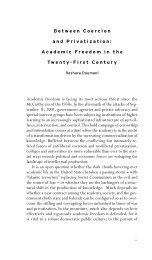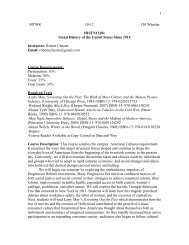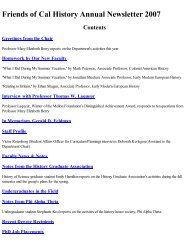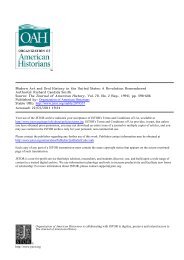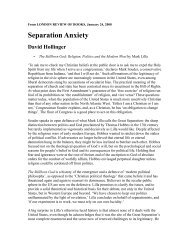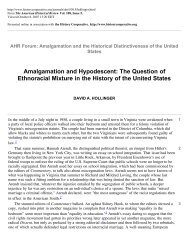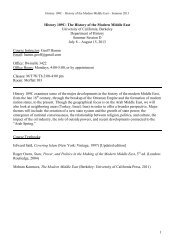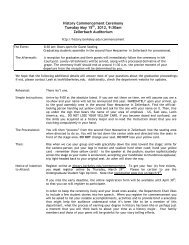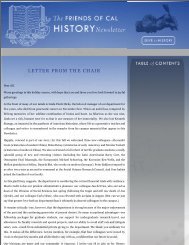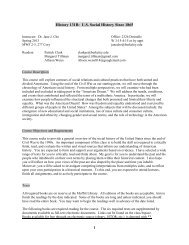My Grandmother and Other Stories: Histories of the Palestinians as ...
My Grandmother and Other Stories: Histories of the Palestinians as ...
My Grandmother and Other Stories: Histories of the Palestinians as ...
Create successful ePaper yourself
Turn your PDF publications into a flip-book with our unique Google optimized e-Paper software.
its inhabitants. In Abu Jamil’s record, <strong>the</strong>re are some birth dates <strong>and</strong> most–if not<br />
all–deaths, in addition to marriage contracts, village arguments <strong>and</strong> o<strong>the</strong>r events.<br />
Such a local archive is rare in Palestine’s countryside. It contained extremely valuable<br />
information about my gr<strong>and</strong>mo<strong>the</strong>r, my family, <strong>and</strong> o<strong>the</strong>r villagers in <strong>the</strong> time <strong>of</strong> <strong>the</strong><br />
British M<strong>and</strong>ate. 7<br />
The information in Abu Jamil’s record corroborates some oral accounts, filling<br />
in dates, numbers, <strong>and</strong> details. <strong>My</strong> observations <strong>and</strong> personal memories <strong>of</strong> my<br />
gr<strong>and</strong>mo<strong>the</strong>r merge with ga<strong>the</strong>red oral accounts, <strong>as</strong> well <strong>as</strong> Abu Jamil’s written<br />
records. Thus, <strong>the</strong> sources on which my gr<strong>and</strong>mo<strong>the</strong>r’s story is b<strong>as</strong>ed are unique in<br />
<strong>the</strong>ir exclusiveness, detail <strong>and</strong> comprehensiveness.<br />
This paper traces <strong>the</strong> key episodes in <strong>the</strong> life <strong>of</strong> an ordinary pe<strong>as</strong>ant woman–something<br />
rarely documented in books or historical narratives, which usually revolve around<br />
elite individuals <strong>and</strong> political leaders. It also sheds light on <strong>as</strong>pects <strong>of</strong> social <strong>and</strong><br />
cultural life that remains to this day in <strong>the</strong> shadows <strong>of</strong> conventional histories <strong>of</strong><br />
Palestine’s pe<strong>as</strong>ant population <strong>and</strong> o<strong>the</strong>r marginalized social groups. Fur<strong>the</strong>rmore, this<br />
paper focuses on <strong>the</strong> lot <strong>of</strong> Palestinian women, who are usually absent in historical<br />
accounts <strong>of</strong> <strong>the</strong> Nakba <strong>and</strong> o<strong>the</strong>r cat<strong>as</strong>trophes that befell <strong>the</strong> <strong>Palestinians</strong>. In short,<br />
my gr<strong>and</strong>mo<strong>the</strong>r’s story opens a new window to Palestine’s social history, especially<br />
that before <strong>the</strong> Nakba. I hope o<strong>the</strong>rs will follow <strong>the</strong> same path, in order to provide a<br />
deeper <strong>and</strong> more comprehensive underst<strong>and</strong>ing <strong>of</strong> Palestinian social <strong>and</strong> cultural life.<br />
This paper is a model for a local bottom-up micro-history, in contr<strong>as</strong>t with <strong>the</strong> overall<br />
comprehensive political histories abundant in Arabic libraries. At <strong>the</strong> same time, <strong>the</strong><br />
biographical account <strong>of</strong> my gr<strong>and</strong>mo<strong>the</strong>r is integrated with <strong>the</strong> macro socio-political<br />
history <strong>of</strong> Palestine during <strong>the</strong> first half <strong>of</strong> <strong>the</strong> twentieth century.<br />
The Beginning <strong>of</strong> <strong>the</strong> Road<br />
<strong>My</strong> gr<strong>and</strong>fa<strong>the</strong>r, Salim Hajj Krayyim “Abu Fayyad”, travelled regularly to Dam<strong>as</strong>cus<br />
<strong>and</strong> Huran at <strong>the</strong> start <strong>of</strong> <strong>the</strong> twentieth century. On <strong>the</strong> way <strong>the</strong>re, he usually stopped<br />
over in Ja’uni, which afforded him a safe haven to rest from his travels <strong>and</strong> <strong>the</strong><br />
difficult mountain road before continuing on, usually on horseback. It w<strong>as</strong> in this<br />
modest village, Ja’uni, where Salim Hajj met <strong>the</strong> fa<strong>the</strong>r <strong>of</strong> my gr<strong>and</strong>mo<strong>the</strong>r, Zahra al-<br />
Sayyed. This friendship between <strong>the</strong> two men streng<strong>the</strong>ned <strong>as</strong> a consequence <strong>of</strong> <strong>the</strong>se<br />
repeated trips, ongoing until <strong>the</strong> tragic years <strong>of</strong> <strong>the</strong> First World War. The elderly recall<br />
how <strong>the</strong> Ottomans recruited young men <strong>and</strong> led <strong>the</strong>m to <strong>the</strong> battlefront far from <strong>the</strong>ir<br />
homes <strong>and</strong> countries. 8 After <strong>the</strong> outbreak <strong>of</strong> <strong>the</strong> war in November, 1914, <strong>the</strong> Ottomans<br />
also drafted Salim’s son Fayyad, who w<strong>as</strong> in his early twenties, even though he w<strong>as</strong> an<br />
only child <strong>and</strong> w<strong>as</strong> married with a small baby.<br />
Jerusalem Quarterly 30 [ 61 ]



